Microsoft 70-533 Exam Practice Questions (P. 3)
- Full Access (246 questions)
- Six months of Premium Access
- Access to one million comments
- Seamless ChatGPT Integration
- Ability to download PDF files
- Anki Flashcard files for revision
- No Captcha & No AdSense
- Advanced Exam Configuration
Question #11
You administer an Azure subscription with an existing cloud service named contosocloudservice. Contosocloudservice contains a set of related virtual machines
(VMs) named ContosoDC, ContosoSQL and ContosoWeb1.
You want to provision a new VM within contosocloudservice.
You need to use the latest gallery image to create a new Windows Server 2012 R2 VM that has a target IOPS of 500 for any provisioned disks.
Which PowerShell command should you use?
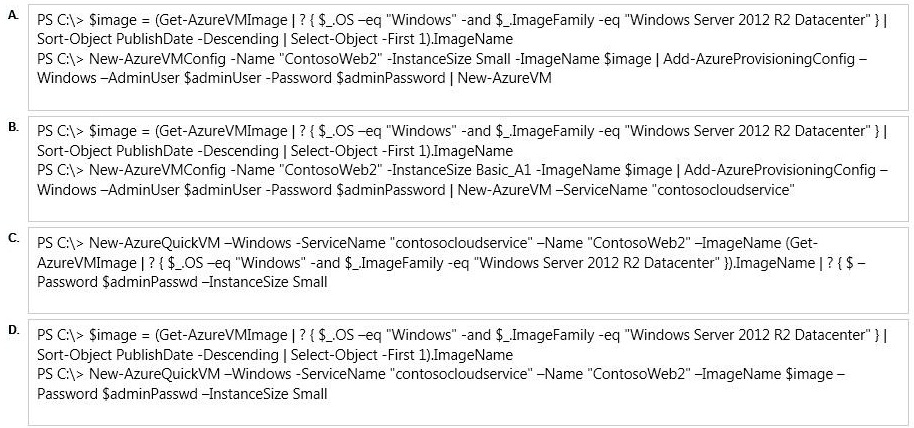
(VMs) named ContosoDC, ContosoSQL and ContosoWeb1.
You want to provision a new VM within contosocloudservice.
You need to use the latest gallery image to create a new Windows Server 2012 R2 VM that has a target IOPS of 500 for any provisioned disks.
Which PowerShell command should you use?

- AOption A
- BOption B
- COption C
- DOption D
Correct Answer:
D
The New-AzureQuickVM cmdlet sets the configuration for a new virtual machine and creates the virtual machine. You can create a new Azure service for the virtual machine by specifying either the Location or AffinityGroup parameters, or deploy the new virtual machine into an existing service.
AdminUsername is not required.
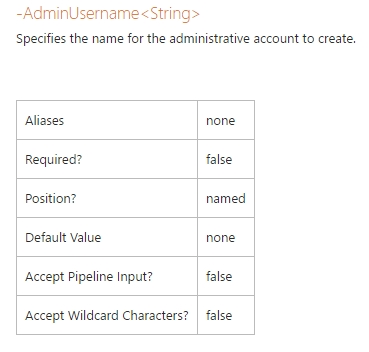
References:
https://msdn.microsoft.com/en-us/library/azure/dn495183.aspx
D
The New-AzureQuickVM cmdlet sets the configuration for a new virtual machine and creates the virtual machine. You can create a new Azure service for the virtual machine by specifying either the Location or AffinityGroup parameters, or deploy the new virtual machine into an existing service.
AdminUsername is not required.

References:
https://msdn.microsoft.com/en-us/library/azure/dn495183.aspx
send
light_mode
delete
Question #12
DRAG DROP -
You administer an Azure Virtual Machine (VM) named server1. The VM is in a cloud service named ContosoService1.
You discover that the VM is experiencing storage issues due to increased application logging on the server.
You need to create a new 256-GB disk and attach it to the server.
Which Power Shell cmdlets should you use? To answer, drag the appropriate cmdlet to the correct location in the Power Shell command. Each cmdlet may be used once, more than once, or not at all. You may need to drag the split bar between panes or scroll to view content.
Select and Place:
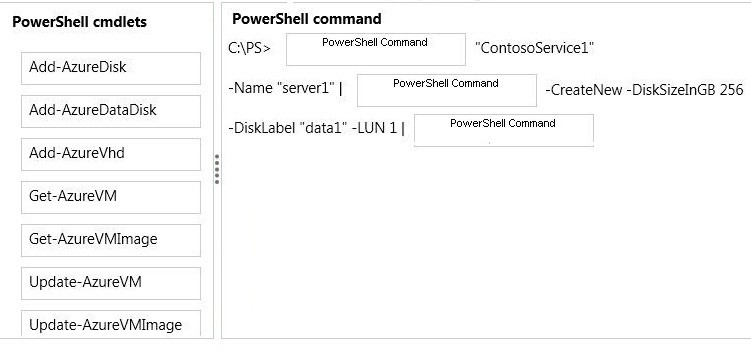
You administer an Azure Virtual Machine (VM) named server1. The VM is in a cloud service named ContosoService1.
You discover that the VM is experiencing storage issues due to increased application logging on the server.
You need to create a new 256-GB disk and attach it to the server.
Which Power Shell cmdlets should you use? To answer, drag the appropriate cmdlet to the correct location in the Power Shell command. Each cmdlet may be used once, more than once, or not at all. You may need to drag the split bar between panes or scroll to view content.
Select and Place:

Correct Answer:
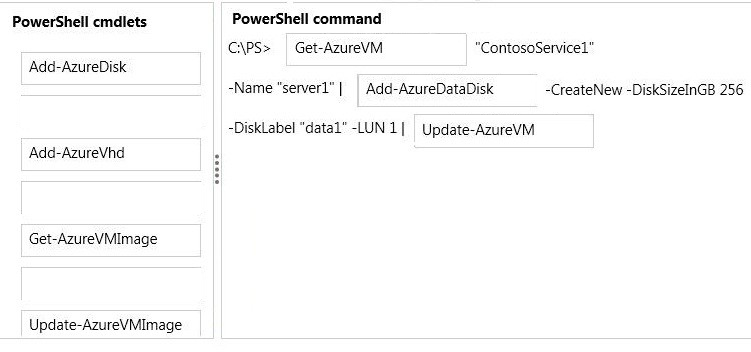
This example gets a virtual machine object for the virtual machine named "MyVM" in the "myservice" cloud service, updates the virtual machine object by attaching an existing data disk from the repository using the disk name, and then updates the Azure virtual machine.
Windows PowerShell -
C:\PS>Get-AzureVM "myservice" -Name "MyVM" `| Add-AzureDataDisk -Import -DiskName "MyExistingDisk" -LUN 0 `| Update-AzureVM
References:
http://msdn.microsoft.com/en-us/library/dn495298.aspx

This example gets a virtual machine object for the virtual machine named "MyVM" in the "myservice" cloud service, updates the virtual machine object by attaching an existing data disk from the repository using the disk name, and then updates the Azure virtual machine.
Windows PowerShell -
C:\PS>Get-AzureVM "myservice" -Name "MyVM" `| Add-AzureDataDisk -Import -DiskName "MyExistingDisk" -LUN 0 `| Update-AzureVM
References:
http://msdn.microsoft.com/en-us/library/dn495298.aspx
send
light_mode
delete
Question #13
Your company has two cloud services named CS01 and CS02. You create a virtual machine (VM) in CS02 named Accounts.
You need to ensure that users in CS01 can access the Accounts VM by using port 8080.
What should you do?
You need to ensure that users in CS01 can access the Accounts VM by using port 8080.
What should you do?
- ACreate a firewall rule.
- BConfigure load balancing.
- CConfigure port redirection.
- DConfigure port forwarding.
- ECreate an end point.
Correct Answer:
E
All virtual machines that you create in Azure can automatically communicate using a private network channel with other virtual machines in the same cloud service or virtual network. However, other resources on the Internet or other virtual networks require endpoints to handle the inbound network traffic to the virtual machine.
References:
http://azure.microsoft.com/en-us/documentation/articles/virtual-machines-set-up-endpoints/
E
All virtual machines that you create in Azure can automatically communicate using a private network channel with other virtual machines in the same cloud service or virtual network. However, other resources on the Internet or other virtual networks require endpoints to handle the inbound network traffic to the virtual machine.
References:
http://azure.microsoft.com/en-us/documentation/articles/virtual-machines-set-up-endpoints/
send
light_mode
delete
Question #14
You administer a solution deployed to a virtual machine (VM) in Azure. The VM hosts a web service that is used by several applications. You are located in the US
West region and have a worldwide user base.
Developers in Asia report that they experience significant delays when they execute the services.
You need to verify application performance from different locations.
Which type of monitoring should you configure?
West region and have a worldwide user base.
Developers in Asia report that they experience significant delays when they execute the services.
You need to verify application performance from different locations.
Which type of monitoring should you configure?
- ADisk Read
- BEndpoint
- CNetwork Out
- DCPU
- EAverage Response Time
Correct Answer:
B
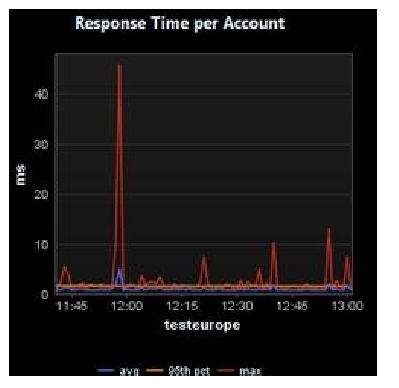
The question states: "You need to verify application performance from different locations". The question is not asking you to determine WHY the application is slow, its asking you to measure the performance from different locations.
Endpoint Monitoring monitors your server with HTTP Get requests from locations that you choose.
References:
https://azure.microsoft.com/en-us/documentation/articles/web-sites-monitor/#webendpointstatus https://azure.microsoft.com/en-us/documentation/articles/app-insights-web-monitor-performance/
B

The question states: "You need to verify application performance from different locations". The question is not asking you to determine WHY the application is slow, its asking you to measure the performance from different locations.
Endpoint Monitoring monitors your server with HTTP Get requests from locations that you choose.
References:
https://azure.microsoft.com/en-us/documentation/articles/web-sites-monitor/#webendpointstatus https://azure.microsoft.com/en-us/documentation/articles/app-insights-web-monitor-performance/
send
light_mode
delete
Question #15
You are the administrator for three Azure subscriptions named Dev, Test, and Prod.
Your Azure PowerShell profile is configured with the Dev subscription as the default.
You need to create a new virtual machine in the Test subscription by using the least administrative effort.
Which PowerShell command should you use?
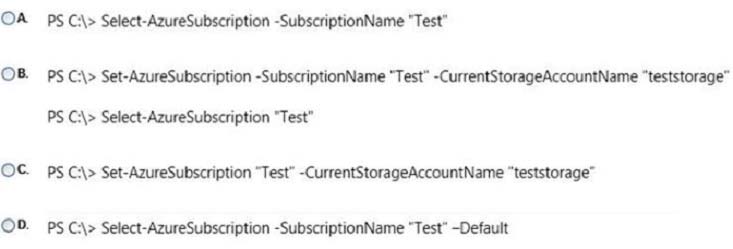
Your Azure PowerShell profile is configured with the Dev subscription as the default.
You need to create a new virtual machine in the Test subscription by using the least administrative effort.
Which PowerShell command should you use?

- AOption A
- BOption B
- COption C
- DOption D
Correct Answer:
A
This command makes Test the current subscription.
C:\PS> Select-AzureSubscription -SubscriptionName Test -Current
References: http://msdn.microsoft.com/en-us/library/dn722499.aspx
A
This command makes Test the current subscription.
C:\PS> Select-AzureSubscription -SubscriptionName Test -Current
References: http://msdn.microsoft.com/en-us/library/dn722499.aspx
send
light_mode
delete
All Pages
